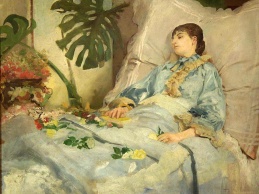[Numbers in square brackets refer to posts listed on the right and at the Home/Archives page.]
In 2004, after that fateful ‘simple’ biopsy operation on my spinal cord tumour by the eager Neurosurgeon, I spent three months in a rehab-geriatrist ward to learn to be a wheelchair user. There was another ‘long stay’ patient in the surgery ward: a young woman, who had a young daughter, was lying on her stomach on a special self-propelled bench/bed with wheels for her to wheel herself around — a kind of ‘stretched’ wheelchair, like a stretched limousine. She was waiting for an open wound in one of her buttocks to heal. She frequently came into the exercise clinic to receive heat and other treatment to relieve the tense muscles around her neck and shoulders. We gradually got to talk to each other and visited each other in our respective room. One day we had the following conversation.
‘How long have you been in a wheelchair?’
‘Fourteen years.’
‘Do you have pain’
‘Yes, of course.’
‘What’s it like?’
‘Exploding, burning, stabbing, electric shock, and more.’
‘That’s what I have too! Will it ever go away?’
‘No, never! It is chronic! From spinal cord injury.’
‘How do you cope with such constant, excruciating pain?’
‘You just learn to ignore it.’
‘How is it possible at all? The pain is always there!’
‘Yes, it is possible, given the time.’
‘But how?’
‘You will learn to do that.’
.
.
.
.
.
.
.
It was totally beyond my belief, understanding, and imagination! How is it possible at all to ignore such constantly present, often excruciating, strange sensations in the legs I can no longer move, in the thighs and buttocks that are always in contact with a seat cushion or a mattress, and in the feet that are always firmly placed on the footplate of the wheelchair? There is no practical way to free the painful parts from those contact surfaces unless I could fly up to float weightlessly in the air, in a vacuum. [32]
How is it possible at all not to feel all the soundless and invisible crackling, crunching, stabbing, pricking, drilling, pulsating, burning, freezing sensations that are constantly going on from my lower chest wall down to my toes! [03] How is it possible not to feel the hypersensitive pain in my right leg when it is touched even most gently? [03]
The pain is there all the time, in whatever position and posture I am in, whether sitting up or lying down in bed, lying on the side or on my back. It is present in whatever I do: eating, showering, talking on the phone, talking to visitors or nurses or the doctor, and repeating the same monotonous arm exercises.
To ignore chronic pain is to intentionally disregard it, that is, to consciously pay no attention to it, not admitting it, not acknowledging its presence or existence. Such a conscious effort may involve denying it, resisting it, fighting against it. My past experience with migraine attacks for nearly 35 years has taught me that the harder I tried to ignore it, to resist it, to fight against it, or to try to stop it, the more intense and debilitating the pain would become, often turning me into a highly stressed, totally helpless, and temporarily incapacitated being!
I didn’t think I could ever manage to intentionally, consciously ignore the ever-present pain. I am always aware of its persistent physical presence and can always feel it internally. Most of the time, I simply just continue doing whatever I am doing or have to do, amid the pain, despite the pain. It is likely that I simply just take it as background noises like the background music in the shopping centre or sounds and noises outside the house. Sometimes, I am so involved and engrossed in an activity, like editing a poem, that I temporarily forget about it, not feeling it for a while. However, as soon as my concentration goes, I can feel the pain again straight away. Sometimes, the pain is so acute that I simply can’t do anything at all!
The activity I get myself involved in usually serves to distract myself from pain temporarily, such as solving the seemingly endless pain- and disability-related problems, managing my irreversibly changed life, doing simple housework like laundry and simple cooking, conversing with someone on the phone, reading and answering e-mail, learning something new, doing something creative, searching and researching on-line, reading a book, writing about my experience, listening to music, attending a public talk or a play or an opera or a concert, watching television, listening to the radio, looking at the garden, listening to the birds, listening to the wind or the falling rain, watching the clouds in the sky, watching sunrise in front of my east-facing house, exercising, practicing deep breathing, meditating, reciting mantras.
Perhaps, what actually happens is that, over time, I have progressively got used to my chronic pain lurking in the background, and often continued to work through it, if it is not too severe. Consequently, I must have developed a greater tolerance to the persistent pain.
My overall approach is to have the attitude of facing the pain upfront, embracing it, focusing on it, sinking into it, analysing it, understanding it, knowing it, describing it in detail, metaphorising it [36], so as to identify, differentiate, categorise the types of pain in terms of their locations, patterns, frequency, intensity; and working out the triggers so as to prevent further flare-ups.
.
© 2018 K-KLokePhD
.
___________________________________________________________________
NEXT POST: REACTIONS TO PAINKILLERS, DEC 16, 2018
___________________________________________________________________
Abstract Photography 14, by Mostafameraji, own work, 2016. This file is licensed under the Creative Commons Attribution-Share Alike 4.0 International license. At https://commons.wikimedia.org/wiki/File:Abstract_photography_%D8%B9%DA%A9%D8%A7%D8%B3%DB%8C_%D8%A7%D9%86%D8%AA%D8%B2%D8%A7%D8%B9%DB%8C_14.jpg
Abstract Photography 06, by Mostafameraji, own work, 2016. This file is licensed under the Creative Commons Attribution-Share Alike 4.0 International license. At https://commons.wikimedia.org/wiki/File:Abstract_photography_%D8%B9%DA%A9%D8%A7%D8%B3%DB%8C_%D8%A7%D9%86%D8%AA%D8%B2%D8%A7%D8%B9%DB%8C_06.jpg
Infrared of the Galaxy Sky. 2003. By 2MASS/T. H. Jarrett, J. Carpenter, & R. Hurt. http://www.ipac.caltech.edu/2mass/gallery/showcase/allsky_gal_col/index.html.
Copyright notice: http://www.ipac.caltech.edu/2mass/gallery/showcase/copyright.html
This file is in the public domain in the United States because it was solely created by NASA. NASA copyright policy states that “NASA material is not protected by copyright unless noted“. At https://commons.wikimedia.org/wiki/File:Galaxies_of_the_Infrared_Sky_.jpg
________________________________________________________________



 .
. .
.

 My lower body crackles, crunches
My lower body crackles, crunches